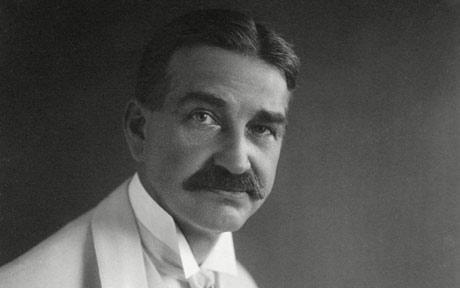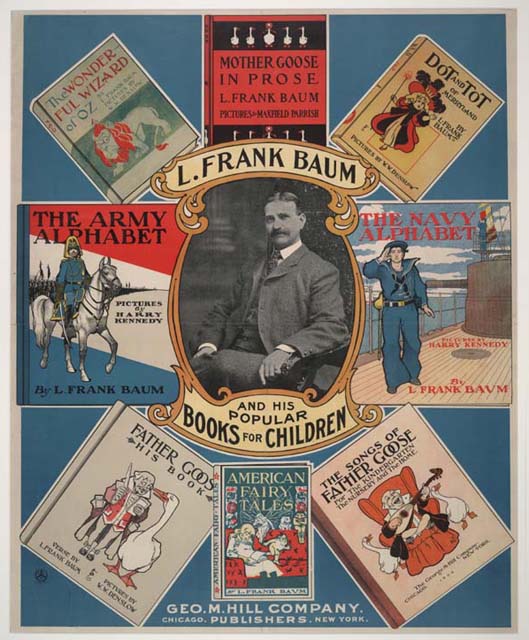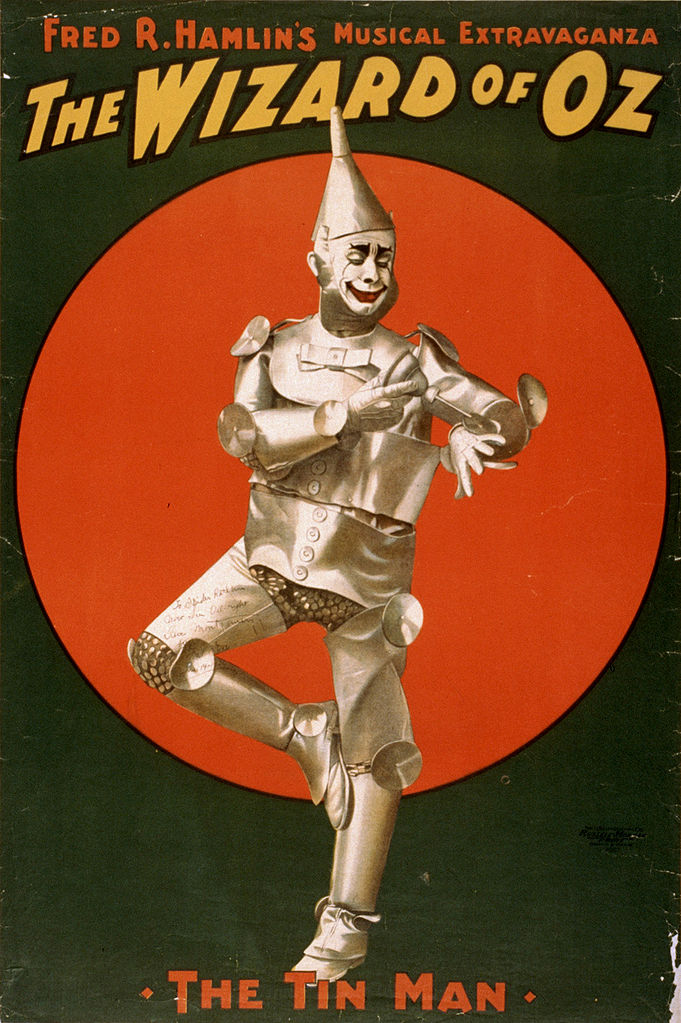- Lyman Frank Baum

Whenever the title "Wizard of Oz" is heard, undeniably the first thing that comes to mind is the beloved 1939 classic starring Judy Garland. The film, which has been said by the Library of Congress to be the most watched film in history, has captivated generation after generation and is the very definition of a timeless film. But the MGM Oz masterpiece is a very small piece of a large pie. The world of Oz did not start out as a film as many believe it to be and was conceived in the mind of one man, a man who will forever be known as "The Founder of Oz". His name is Lyman Frank Baum, and his 1900 book The Wonderful Wizard of Oz would become the focal point of which the 1939 film was based upon. As the 1939 film would go down as one of the best movies ever made, the original novel would go down as one of the best fairy tales ever written on paper, and the man behind it would go down as one of the greatest inspirations, not only to myself, but to many others as well. The works of L. Frank Baum have inspired such people such as Walt Disney, Gregory Maguire, Sam Raimi, and I'm willing to bet that J.K. Rowling was inspired by Baum's work, in one form or another. The Wonderful Wizard of Oz has become a monumental milestone in American literature, spawning many sequels, plays, and other movies, some of which were released decades before the beloved MGM classic.
Growing up in the late 90s early 2000s timeframe, I went berserk when The Wizard of Oz was on television. Every time it was on, it was like a holiday or special event, and even if I missed it, I could still whip out the old weathered VHS tape, catching a glimpse of the land of Oz even if huge white lines soared across the television screen. As I grew older, I saw illustrations from the original Wizard of Oz novel on Christmas ornaments and I grew anxious to read the book, written nearly 4 decades before the MGM film saw the light of day. As infatuated with the MGM film as I was, I expected the novel to be almost identical to the film that was eventually made. Surely, there would be noticeable differences, but little did I know that there would be SEVERAL noticeable differences. Baum's original novel is almost completely different from the classic film, even though the classic film retains the book's overall tone and premise. For one thing, Dorothy's vacation to Oz actually happened and wasn't a dream as it was portrayed in the movie. Her iconic ruby slippers were also silver in the book and fall off and get lost as Dorothy is transported back to Kansas. Glinda, the Good Witch of the North in the movie is the Good Witch of the South in the book and rules over a place called Quadling Country. Another noticeable difference is that the Wicked Witches are not sisters and the Wicked Witch of the West looks completely different than the pointy hatted, green witch we are all familiar with. She is portrayed as an elderly woman with pig tails and an eyepatch, and William Wallace Denslow's illustrations in the original book color her yellow instead of the iconic green she would eventually be known for. Her role in the book is also significantly shorter than her role in the movie, and she summons the Flying Monkeys (known in the book as Winged Monkeys) using a "golden cap".
There are also many other contrasts to the 39 film, such as the inclusions of half tiger, half bear hybrids called kalidahs, creatures called hammerheads, a town where every inhabitant is made of porcelain (something that would be included in the most recent film, Oz The Great and Powerful), green glasses that make the Emerald City...well...emerald, and the Wizard of Oz taking on many different forms as each main character enters his chamber. The point is, the Wizard of Oz novel was far diverse from the film that was eventually made, and I was baffled by how many things I pointed out that differed from the legendary film. Not that I didn't like the book, in fact, it's one of my very favorite novels (I actually have it on my iPhone), but the things that didn't make it into the final film intrigued me, and I think they made the Oz universe much more broader and richer. Of course, there have been several sequels and spinoffs written throughout the years following WWO's original release, such as The Marvelous Land of Oz, Ozma of Oz, The Road to Oz, and....ready for this...Rinkitink of Oz, and each one of them expanded on the fantasy world Baum brought forward while also showing Baum's perspectives and beliefs. Baum believed in non violence and that religious acts should be made by mature minds and not religious authorities. He was also a huge supporter of the Women's Suffrage which is clearly shown in the characters of Dorothy, Glinda and Ozma. Instead of making the women supporting characters and adding touches of feminism, Baum made females the focal point of many of his stories, making Dorothy not an average damsel in distress, but an all out, quick thinking heroine. This is one of the many elements sorely missing in the 39 film, for Judy Garland's Dorothy, while portrayed well, comes off as a crying damsel who needs to be rescued by her friends. In the book, she was the one rescuing her friends!
As I said before, many interpretations of Baum's stories have been done throughout the years, some combining elements from both the original book and the beloved movie. There's of course the 1995 revisionist novel Wicked: The Life and Times of the Wicked Witch of the West written by Gregory Maguire, which was later adapted into a famous musical with music by Stephen Schwartz (the witch's name "Elphaba" comes from the pronunciation of L. Frank Baum's initials). There's the mini-series Tin Man, which puts some sci-fi into the world of Oz and like Wicked, features a bit of adult content. There's the most recent Disney film Oz The Great and Powerful, which teaches us how the wizard, played by James Franco, got into Oz and became what we know him as. But why don't we go back even further, even before the 1939 film everyone knows and loves graced the movie screen. Our time machine takes us back to 1902 when the first ever stage musical of The Wizard of Oz was released. Like many interpretations of Baum's tales, this musical differs drastically from the original book. Elements sorely missing are the Wicked Witch of the West, Toto, and the Cowardly Lion's part is shortened. New characters included in the play are Imogene the Cow, King Pastoria II, Cynthia Cynch, and Sir Dashemoff Daily. Although many of the play's elements remain shrouded in mystery, two things are apparent. Dorothy's surname "Gale" was introduced in this play and it has become the character's last name ever since. In one of the play's scenes, Dorothy is put to sleep in the field of poppies and is revived when the Good Witch sprinkles snow on them. This is one of the things that made it's way into the 1939 film, for the Good Witch Glinda sprinkles snow on the poppies that put Dorothy and the Cowardly Lion to sleep. It is also said that some of the costumes used in the 1902 play were later used in the 1910 silent film, the oldest existing Oz film to date.
The 1910 film, which also differs greatly from the source material, is even more mysterious than the 1902 play. The director, the actors, and the overall credits are shrouded in mystery, but unlike the 1902 play, this 13 minute film features the Wicked Witch of the West (named Momba) as the primary villain. There was also said to be an Oz film before this one that featured hand colored stills (imagine how tedious that must have been!), but overtime, the film decomposed and it is no longer in existence. Another famous Oz movie that came out before the 1939 film was 1925's Wizard of Oz, directed by Larry Semon. Out of all the Oz interpretations, this one is the most different from Baum's original story. The magical elements from the book such as talking scarecrows, tin woodmen, and lions are gone, for the Kansas farmhands (played by Semon, Oliver Hardy, and Spencer Bell) disguise themselves as the characters instead of the characters actually existing. Once again, the Lion's part is limited, and like in the 1902 play, the Wicked Witch of the West and Toto are absent. The villain in this take of Oz is a miser named Prime Minister Kruel, who rules the Land of Oz with an iron fist. Dorothy, who is ironically played by a woman named Dorothy Dwan, is revealed to be the lost princess of Oz named Dorothea, a concept obviously derived from Princess Ozma in the books. The Wizard, played in this film by silent film legend Charles Murray, is more or less of a lumbering henchman who ultimately proves vital in the film's overall plot and story. I also should point out that Oliver Hardy's farmhand, who becomes the Tin Woodman, becomes a villainous trooper of Prime Minister Kruel and chases the other main characters around Kruel's palace at the film's climax. That's right, the Tin Man becomes a villain. And although this film features Oliver Hardy and not Stan Laurel, this film has been associated with Laurel and Hardy many times throughout the years and many confuse Larry Semon with Stan Laurel.
Someone who always wanted to make an Oz picture was Walt Disney. In fact, his 1937 animated film Snow White and the Seven Dwarves inspired MGM to make The Wizard of Oz in the first place. When the rights to Baum's remaining books became available, Disney purchased them, intending to make an animated Oz film in his signature style. A common myth has it that Walt Disney also held the rights to J.R.R. Tolkien's Lord of the Rings series, but that is not true, for Tolkien despised Disney's work. For reasons unknown, Disney never got around to making his Oz movie, and his planned live action film The Rainbow Road to Oz, which was going to star his original Mickey Mouse Club, didn't even make it past the drawing board. Disney also had Oz themed rides for Disneyland in mind, but they never got made either. After his death in 1966, Disney's company fell far from it's former glory, releasing flops such as The Black Cauldron. The same year of The Black Cauldron's release, Disney Studios finally released their take on the land of Oz in Return to Oz directed by Walter Murch. Like The Black Cauldron, this film bombed terribly at the box office and fell under the reign of many critics, some saying that it degenerated what the Wizard of Oz stood for. But since it's release, it has garnished a MASSIVE cult following. I myself have come to adore the film, even if there are some elements in it that don't really add up, in my eyes at least. It combines what we love about the original novels and what we love about the 39 film and blends in a lot of 80s special effects and brilliant stop motion sequences. It is also much darker (no, MUCH MUCH MUCH darker) than the 39 film. Sure the 39 film had Margaret Hamilton's Wicked Witch, creepy blue faced flying monkeys and peed off trees who don't like apples being picked off of them, but this film has some of the creepiest imagery you will ever see in a movie.
There are so many more interpretations of Oz, I've barely boiled the potato. There's of course The Wiz, Journey Back To Oz, the animated Oz TV series from the 90s, the episode of The Shirley Temple Show that was based on The Marvelous Land of Oz, the Disney Oz records, the Marvel Comics version of The Wizard of Oz, and many, many, many, many more. And all of this couldn't have been if it wasn't for L. Frank Baum and his tremendous contribution to the world of storytelling. Baum is the Bomb (literally) and he surely went over the rainbow and back again, creating a universe unlike any other written or illustrated. And with each take on Oz, the universe he brought forward gets bigger and richer, bringing us entertainment and delight and some of the most iconic images that will forever stick out in our brains. He created one of the first American fairy tales and to this day, his Land of Oz has captivated millions and taken them beyond the barn, proving that dreams that you dare to dream can come true.





No comments:
Post a Comment